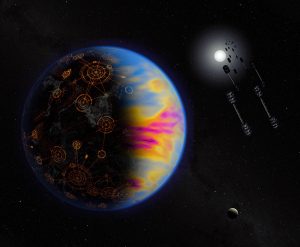
Artist’s illustration of a technologically advanced exoplanet. Image credit:NASA/Jay Freidlander
The idea of life elsewhere is not a new one. Hundreds of years ago it was assumed that there were beings everywhere, before such views were considered heretical, and the determination that places like the Moon were dry airless worlds started to reduce the possible places life could thrive. But even as recently as the mid-20th Century, the idea of vegetation on the surface of Mars was not considered crazy. As the dry, arid nature of Mars became clear, and the hot, hellish surface of Venus was revealed, hope of finding life, or certainly intelligent life, all but disappeared.
There was a flurry of interest in the mid-1990s, when a meteorite that originated on Mars seemed to show signs of fossils of tiny lifeforms. Those turned out to be the product of geology.
But the search goes on, not just in our Solar System, but also beyond. This month, we are joined by Professor Abel Mendez, who is a physicist and astrobiologist at the University of Puerto Rico, based at Arecibo. We got on to shadow biospheres and technosignatures, but we began by going back to basics, with Abel explaining why we even go searching for life elsewhere.





